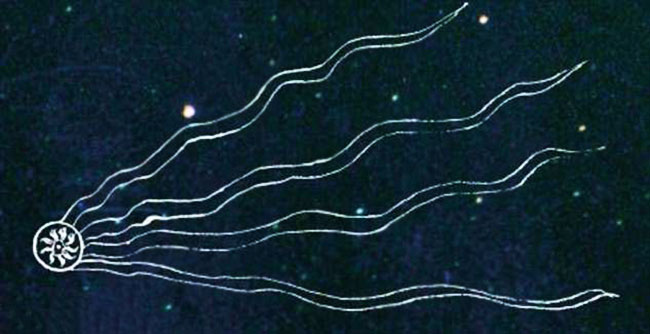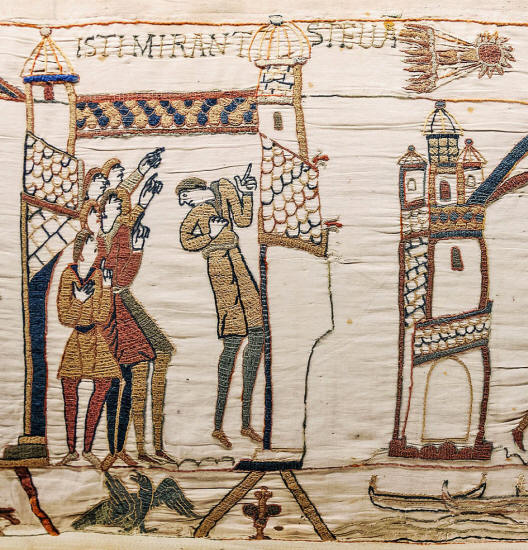|

by Ivan Petricevic
May 05, 2018
from
Ancient-Code Website
Italian
version

By analyzing ancient
manuscripts and data gathered by Anglo-Saxon Astronomers, in
combination with modern data by NASA and other space agencies,
experts from Queen's University hope to narrow down the location of
elusive
Planet Nine (ex-Planet X or 10).
In the distant past, ancient astronomers spotted countless things in
the night sky.
For example, thousands of years ago, the ancient Egyptians
discovered a star located 92 light years away.
Reported in
earlier article, how a study by
scientists from the University of Helsinki
analyzed an ancient Egyptian
papyrus and found it is the oldest preserved historical text of
naked-eye observations of a variable star located 92 light years
away, the eclipsing
binary star Algol.

An 1145 depiction of 'Halley's Comet'.
Image
Credit: Queen's University Belfast.
Now, scientists at Queen's University in Belfast believe how trails
of dust and gas in the night sky, spotted by Anglo-Saxon astronomers
may provide evidence of the mysterious Planet Nine.
In 2016, astronomers from
Caltech published a study reporting
the existence of an undiscovered planet, located in the outermost
reaches of our solar system.
It is estimated that Planet Nine has ten times the mass and two to
four times the diameter of the Earth.
According to Caltech astronomers, Planet Nine has a massive orbit,
meaning that it takes between 10,000 and 20,000 years to make a
single pass around the sun.
But even before 2016 have astronomers debated whether such a rogue
planet may exist at the edge of our solar system. Despite searching
for the elusive world, astronomers on Earth have still not managed
to find it.
According to news reports of January 2016, astronomer
Michael Brown
suggests there is a ninety percent probability that such
a planet really exists.
Astronomers say that the
existence of such an alien world would explain the strange way
distant objects in space move.

This is the Bayeux Tapestry
and it
features a depiction of the 1066 Halley's Comet.
Now,
experts from Queen's University Belfast
say
that trails of dust and gas in the night sky
recorded by ancient Anglo-Saxon astronomers
may
contain evidence of the elusive Planet Nine.
Image
Credit: Wikimedia Commons.
And since Planet Nine has eluded discovery, scientists from Queen's
University believe how ancient depictions of comets in the Dark Ages
may provide crucial data on the whereabouts of the mysterious alien
world.
Experts believe how ancient Anglo-Saxon accounts, together with
modern scientific methods could be used to investigate the effects
of such a world and spot it in the sky.
According to medieval historians and astronomers from Queens
University, we may learn about the enigmatic planet by exploring the
Anglo-Saxon understanding of
the Cosmos.
Experts combine record of comets spotted by Anglo-Saxon astronomers,
as well as contemporary images of space objects, including data
obtained from NASA and The Northern Ireland Amateur Astronomy
Society.
By combining modern data with ancient accounts, researchers believe
they could narrow down the location of planet nine.
"This research
project renegotiates the meaning and importance of medieval
science and demonstrates how medieval records of comets can help
test the theory of the existence of the elusive 'Planet Nine'."
"Looking at records of comets in Old English, Latin, Old Irish
and Russian texts we aim to show that the early medieval people
actually recorded genuine astronomical observations, reflecting
their interest in cosmology and understanding of the heavens.
The idea for this
study came about from the strong desire to challenge the
assumption and perceived lack of scientific inquiry in the early
Middle Ages, commonly referred to as 'Dark Ages'," explain
experts.
Dr. Pedro Lacerda,
an astrophysicist, and expert on comets and the solar system at
Queen's added:
"It is fantastic to
be able to use data which is about one thousand years old to
investigate a current theory. To me, this is one of the most
fascinating aspects of our project."
"Any strong indication that a 'Planet Nine' is required to fit
the comet sightings recorded in the Middle Ages will be a unique
result and will certainly have a remarkable impact on our
understanding of the solar system."
Reference
|




